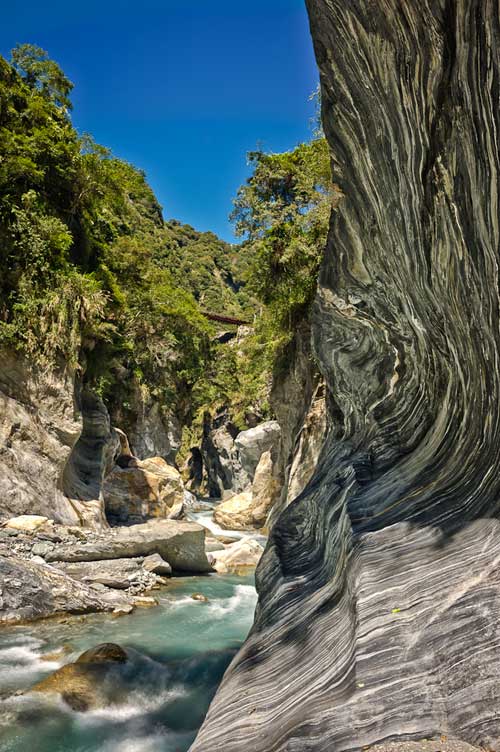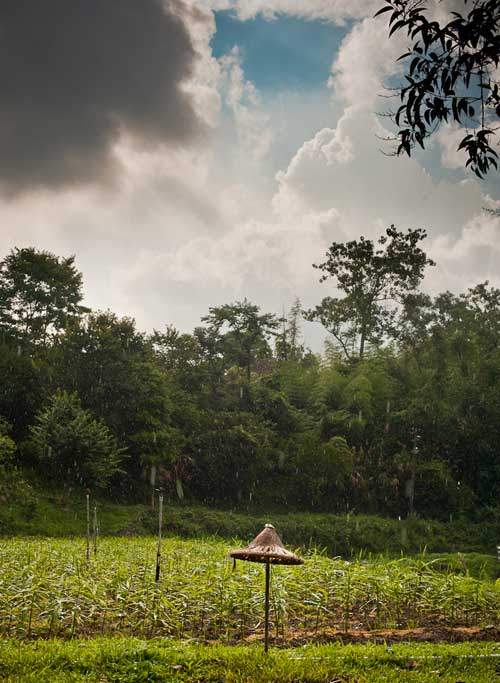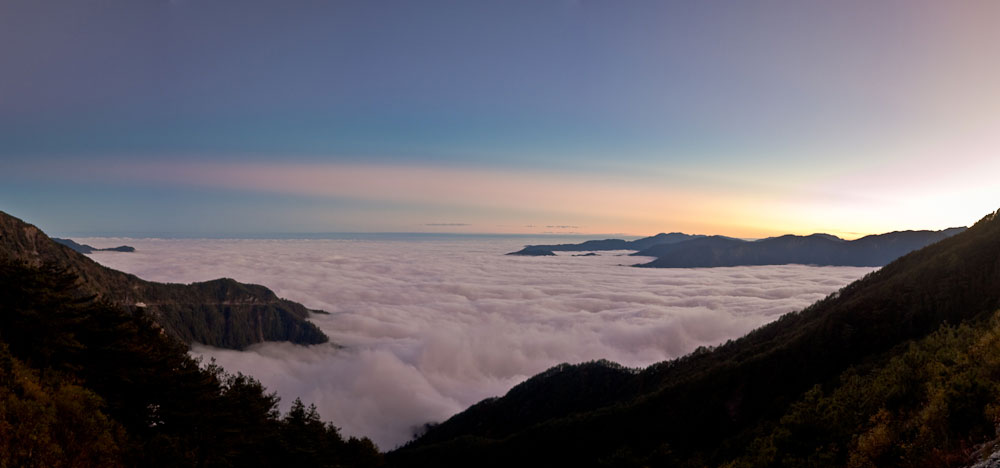Geography & Climate
For a relatively small island, Taiwan is incredibly mountainous. The reasons for this aren’t hard to understand. The island is located on the eastern edge of the Eurasian tectonic plate, where it meets the Philippine Sea plate. The latter is continually moving westward, and sliding under the Eurasian plate, pushing it higher at the rate of approximately 5 mm (a fifth of an inch) per year. As a result, almost a third of the main island is 1,000 m (3,281 ft) or more above sea level.
Hiking above the clouds
You’ll see mountains, among them the peaks that make up Yangmingshan National Park, as soon as you arrive in Taipei. One tenth of Taiwan is over 2,500 metres (8,202 ft) while a total of 258 peaks are more than 3,000 metres (9,843 ft) high, the very highest being Mount Jade (no. 2 and no. 3 respectively are Snow Mountain and Xiuguluanshan). Most of the high peaks are located along the Central Mountain Range, which runs 270 km (168 miles) from north to south. However, both Mount Jade and Alishan belong to separate ranges, while the mountains closest to the Pacific Ocean comprise the Coastal Mountain Range. Thanks to a network of well-maintained roads, it’s possible to enjoy stunning upland vistas without leaving your vehicle. Indeed, for many visitors who join Life of Taiwan private guided tours, the drive from Sun Moon Lake to Taroko Gorge is a highlight.
Four of Taiwan’s eight national parks preserve high-altitude environments, leaving hikers are spoiled for options. In addition to hundreds of trails suitable for half-day or day-long hikes – some of which are conveniently close to the capital – there are epic paths which require six to eight days plus proper camping equipment and provisions. These should not be attempted without an experienced guide; would-be trekkers must also obtain the correct permits or run the risk of a stiff fine.
Taiwan’s hot springs

For sheer variety, these soothing spas are astounding. In terms of temperature, mineral content or setting, no two are alike. At many of them, the temperature exceeds 45 degrees Celsius (113 degrees Fahrenheit), so visitors shouldn’t fully immerse themselves right away, but rather acclimatise by scooping water and pouring it over themselves, then slowly lowering themselves in.
First-timers are often surprised to learn that after indulging in a hot spring, they shouldn’t shower before dressing, but rather let their skin benefit from the trace quantities of sulphur, sodium carbonate and other minerals in the water.
Many springs are conveniently close to major cities. People based in Taipei are fortunate in having on their doorsteps the famous hot springs of Xinbeitou and Wulai. East Taiwan is riddled with springs; luxurious hotels have been built at some while others remain remote and entirely undeveloped, and can only be reached by 4×4 vehicle or on foot. Hikers will find that, when their legs are aching, nothing beats a good soak.
When the Japanese took control of Taiwan in 1895, they brought with them their well-developed onsen (hot springs) culture. From the foreign tourist’s perspective, Taiwan’s hot springs have certain advantages over their Japanese counterparts. Whereas segregation by gender and nudity are the norm for springs in Japan, swimsuits are worn at most public hot-spring pools in Taiwan. Families can splash and soak together in these places, many of which are open-air and set against a scenic backdrop of mountains and forest.
Cliffs and beaches
Taiwan and the country’s minor islands together have almost 1,700 km of coastline and the range of landscapes is tremendous. Much of the west coast is characterised by lagoons, mudflats, and wetlands where migrating birds spend the winter, while the north coast is notably rocky. Between Hualien and Yilan, the land meets the sea in a range of breathtaking cliffs. Off the southern coast there are coral reefs full of life and tidal platforms where it’s easy to spot crabs, sea hares, and other beguiling creatures.
Taiwan has scores of beaches with several of the nicest ones being stretches of white sand in Penghu County and alluring coves in Kenting National Park. In Kinmen County and the Matsu Islands, you can find seaside spots where you’ll have superb views and ocean breezes all to yourself.
Climate

In Taipei the mercury sometimes dips below 10 degrees Celsius (50 degrees Fahrenheit) during winter, but on summer afternoons it can reach 35 degrees Celsius (95 degrees Fahrenheit). Cities south of the Tropic of Cancer, which crosses Taiwan near Alishan, never get truly cold. Winters in this region are generally dry and sunny. In many ways, October to March is an ideal season to visit Taiwan. Temperatures in the outlying islands of Kinmen and Matsu are often 5 degrees Celsius lower than in Taipei.
Rainfall varies hugely from place to place. The wettest spots are certain foothill areas near Taipei which in a typical year receive almost 6,000 mm of precipitation. That’s a lot, but during typhoons parts of Taiwan have been hit with more than 2,000 mm (nearly 79 inches) of rain in less than 48 hours.
Wet season, dry season
According to official data, Taiwan’s annual average precipitation is 2,502 mm (98 inches). In the north, the average is 2,932 mm (99 inches). In the central region, the south, and the east, the numbers are 2,154 mm (85 inches), 2,521 mm (99 inches) and 2,543 mm (100 inches). For Taipei, the wettest period is usually June to August. In the south, the wet season is even more pronounced: Three quarters of Tainan’s annual rainfall comes between late May and late August. Taiwan’s minor islands are all quite dry. Kinmen County, for instance, gets 1,089 mm (43 inches) of rain in a typical year.
Each winter snowfall adds to the beauty of Taiwan’s highest mountains, but seldom in such quantities that skiing is possible. The Central Cross-Island Highway and the approach to Hehuanshan are sometimes closed due to snow and/or ice.
Typhoons are an occasional hazard. Most arrive in late summer, and even if they don’t hit Taiwan head-on, they’re likely to bring heavy rains which can disrupt transport and make travelling in the mountains inadvisable.


